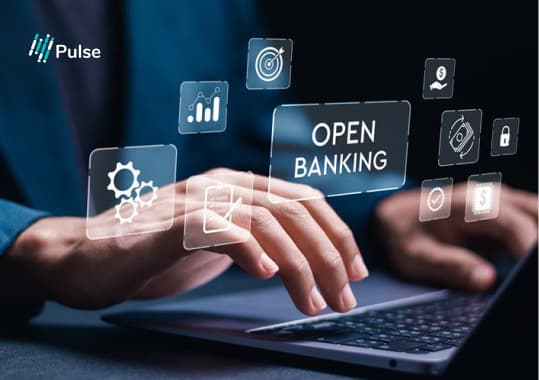From fractured approval pipelines to risk exposures, the era of static credit-bureau scores is giving way to ecosystems defined by real-time data flows, embedded finance models, and alternative data sources. In 2025, the convergence of three factors is reshaping how lenders build origination, underwriting, and ongoing monitoring engines. These are open banking, embedded lending, and non-traditional data sources. Below, we will delve into how each element is evolving, how its functionality intersects, and the subtleties we must prepare to contend with.
Data as a Catalyst For Embedded Lending
Embedded lending. i.e. credit and financing are flourishing in the UK. One recent analysis notes that as of Q2 2025, over 12 million UK consumers and businesses are active users of open banking, driven in large part by embedded finance credit flows.
Embedded lenders rely on being present where the customers already transact, and real-time data is what turns such presence into underwriting muscle. Instead of “sit-down and fill in a loan application with three months of bank statements”, the underwriting engine pulls transaction flows and assorted financial data and integrates them into an API-driven decision engine that can approve deals within minutes. For example, Pulse’s signature underwriting solution, Einstein aiDeal, automates underwriting and is capable of processing thousands of applications simultaneously, while auto-decisioning 95% of deals in under 45 seconds.
In effect, data becomes a highly coveted credit asset that banks, lenders, accountants, and advisors race to collect, standardise, unify, and feed into AI and ML models. The consequence? The boundary between a “vendor platform” and “lender” blurs, because the stakeholder who harnesses real-time data and integrates underwriting solutions becomes capable of fast, accurate, data-driven decisions, thus perfectly capable of leveraging embedded lending in an optimal manner. But this shift raises hard questions: What types of data matter most? How do you ingest, normalise and integrate them? And how is regulatory and operational risk managed in real time?
The Role of Open Banking as the Anchor
In the UK, open banking has matured beyond “bank account-sharing for payments” into the infrastructure enabling embedded lending. As of March 2025, the UK had 13.3 million active open banking users
- API activity has exploded: in July 2025, the ecosystem saw over 2 billion API interactions, and over 15 million users in a month.
- The economic impact is substantial: open banking in the UK supports an approximate economic value of £4.1 billion.
For embedded lending, open banking delivers three specific capabilities:
- Real-time affordability and cash-flow visibility: Transaction feeds reveal income deposits, recurring outgoings, bill payment patterns, and, by extension, disposable income. Real-time affordability checks are essential for effective embedded lending.
- Thin-file and credit-invisible access: Legacy credit bureau models exclude people with limited credit history. In one case study, the lender enabled access to over 112,000 thin-file borrowers using open banking data.
- Embedded channel integration: Instead of redirecting users to lender apps, credit offers are surfaced within systems the user is already using (e.g., accounting software, e-commerce checkout, etc.). Open banking APIs make this feasible and scalable.
Thus, open banking isn’t merely an enabler; it acts as the root for embedded lending.
Alternative Data: Beyond Open Banking
While open banking is quickly becoming the ‘minimum viable’ data layer, embedded lenders in the UK are increasingly layering in “alternative data”, which is any non-traditional or non-bureau credit data. For example, utilities, telecoms, behavioural online signals, aggregated platform data, supply-chain payment flows, etc..
The following factors indicate how the value of alternative data is indeed tangible:
- According to LexisNexis/CCTA research, 84% of UK lenders reported increased confidence in using non-traditional data sources in consumer lending decisions.
- 91% of lenders believe that traditional data alone fails to provide a full view of at least a quarter of applicants.
- The world of business lending is also shifting: SaaS companies and financial institutions underwriting using cash-flow and alternative data are growing rapidly, while high-street banks are playing catch-up.
The intersection between embedded lending and alternative data is very compelling: embedded-lending platforms (whether at checkout, in accounting, or via gig-economy apps) often generate rich, proprietary behavioural and transactional data, including invoice turnover, supply-chain payment consistency, platform servicing records, and user lifecycle behaviour. These can all become underwriting ingredients.
For instance, imagine a SaaS marketplace offering embedded invoice funding: the marketplace knows each vendor’s invoicing preferences, payment settlement history, platform complaints, churn, contract renewal rate, etc. These signals are not on a bureau file, but they can tell a lender, “this vendor has 6 months of stable monthly invoicing of £40k, 98 % settlement, churn trending downwards; we can underwrite £100k working-capital advance now.” That data sits outside open banking but is potentially “alternative data”.
Moreover, alternative data helps address the “thin-file” challenge: for borrowers whose only visible credit relationship is one or two products, other triggers (platform behaviour, rental history, utilities, smartphone payment behaviour) supply incremental predictive capacity. Alternative credit data allows you to form a comprehensive picture of an individual’s creditworthiness with new information, which often adjusts the assessment of an applicant.
The Synergy in Practice: How Embedded Lending Models Deploy Data
To understand the composite effect, consider the lifecycle of an embedded lending decision in 2025 UK:
Origination and In-Platform Offers
A user in an e-commerce checkout or an SME in accounting software sees a “Finance Now” button. Behind the scenes, the platform has a plug-and-play API for a lending originator. The borrower consents to open-banking feed and other platform-derived data.
Underwriting Engine
- Open-banking feed provides income deposit patterns, outgoing commitments (scrolling as horizontal expense categories), and disposable cash flow (income minus essentials).
- Alternative data layers attach: platform transaction behaviour (for marketplaces), invoice fulfilment history (for SMEs), third-party utilities/telecoms/-pay data (if available).
- Machine models score the borrower in real-time; the decision outcome surfaces, and the loan is executed nearly immediately. SaaS companies like Pulse offer a Unified Lending Interface (ULI) with modular solutions like Pulse’s Loan Origination System (LOS), which can digitise and reduce the loan application process to under 3 minutes, while Einstein aiDeal: Pulse’s signature underwriting solution can auto-decision 95% dels in under 45 seconds with customisable criteria. To learn more about Pulse ULI, contact us today.
Embedded Channel Experience
The entire flow takes place within the user’s familiar digital environment; the borrower doesn’t exit to a standalone lender portal. That enhances conversion and lowers operational cost.
Monitoring and Portfolio Risk Management
Post-disbursement, the same data flows feed continuous monitoring: changes in bank flows, platform transaction drop-offs, late payments, and expense spikes all activate risk triggers. Embedded lenders can act faster when early warning signs appear. Pulse’s Loan Management System (LMS) can help track repayments, defaults and delays.
This synergy of open banking + alternative data + embedded channel provides three strategic functions:
- Extends credit access by servicing thin-file and unconventional borrowers;
- Lowers origination costs via API automation and embedded flows;
- Improves loss performance via richer data and earlier monitoring.
Yet it also embeds new risk contours: data ingestion and model controls become mission-critical, not optional.
Conclusion
Embedded lending is shifting from a trend to mainstream. But making it work at scale demands more than plugging in an API. Advanced lenders are building data-rich, embedded flows that leverage open banking and alternative data to reach underserved segments, improve risk performance, and reduce friction. The payoff is clear: improved conversion, lower costs, better inclusion and sharper portfolio outcomes. Data is the lens through which credit decisions will be made, and in 2025, the firms that master this lens will shape the next wave of embedded finance, with companies like Pulse serving as catalysts.
Related Blogs


